Bamboo
Especially useful for food preparation and service, bamboo bowls and plates can be used for hot and cold foods, and washed by hand bamboo products will last almost a lifetime.
A truly environmentally friendly resource, bamboo is one of earth’s fastest growing plants and is naturally antibacterial and durable.  It's biological characteristic makes it the perfect tool for preventing soil erosion and reducing carbon dioxide levels in the atmosphere, generating up to 35% more oxygen than trees.
It's biological characteristic makes it the perfect tool for preventing soil erosion and reducing carbon dioxide levels in the atmosphere, generating up to 35% more oxygen than trees.
Bamboo needs no replanting and it grows without fertilisers or pesticides. It also plays an important role in the reduction of timber consumption.
Using the centuries old technique of bamboo coiling also known as spun bamboo, thin strips of bamboo are soaked for two months, then coiled inside a mould, glued, dried, sanded and coated many times with lacquer, a food-safe finish. As a result of the traditional manufacturing process, no two pieces are identical.
Bamboo bowls are available in natural or coloured in many different shapes and sizes. To see our full range visit our bamboo bowls and platters page.
Silk Lanterns

Handmade lanterns from the ancient sea side town of Hoi An which is often described as the ‘City of Lanterns.’ The lanterns are thought to be symbolic of hope and good luck wherever they are hung.
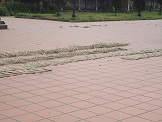
Our handcrafted silk lanterns are made from finely woven silk and bamboo by skilled artisans in organic shapes that echo the fish traps upon which they are based.
Each of these Vietnamese inspired silk lanterns is carefully constructed with hand harvested bamboo.
The bamboo is first washed and baked in the sun to season it before it forms the natural framework of the lantern.
The surrounding fabric is made of pure silk. The silk has beautiful colours and meaningful patterns that bear distinctive cultural elements.
Beautiful when suspended, inside or out, in clusters of glorious colour and shapes, the sight of a silk lantern always takes us back to the idyllic fishing village of HoiAn.
Visit our online store to see the full range of Vietnamese silk lanterns available for purchase.
Quilling
A modern take on the centuries old craft of quilling, strips of paper are used to create modern funky animals.
Quilling is a traditional art form that involves the use of small strips of paper that are rolled, shaped and glued together to create decorative designs.
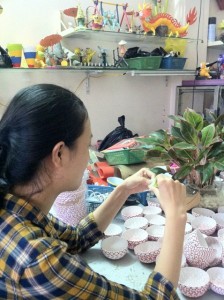
The craft has gone through many transformations through the ages incorporating new techniques, styles and materials.
During the renaissance French and Italian monks used quilling to decorate book covers and religious items. The paper most commonly used was strips of paper trimmed from the gilded edges of books.
In the 18th century, quilling became popular in Europe where gentle ladies of quality ("ladies of leisure") practiced the art. It was one of the few things ladies could do that was thought not too taxing for their minds or gentle dispositions.
Quilling also spread to the Americas and there are a few examples from Colonial times.
Quilling works of art can be found in art galleries across Europe and the United States and is recognized as an art that is practiced around the world.
Lacquerware
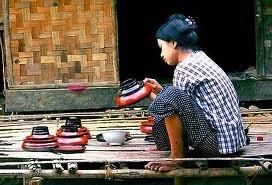
Vietnamese people have used natural resin extracted from lacquer trees to produce lacquer products to serve everyday life for thousands of years and many lacquer products have been found in ancient tombs. The art of lacquerware was handed down from generation to generation as a family secret until the first half of the 20th century.
Today, Vietnamese lacquerware is meticulously handmade in just two villages north of Hanoi. Lacquer resin comes from lacquer trees found growing mostly in the North of Vietnam. When first extracted from a tree, the lacquer is a white, condensed like milk then turning brown in the air as it oxidises, and gradually becoming black when dried. Mixed with a solvent it becomes clear and hard when dried. Each piece of Vietnamese lacquerware usually goes through 20 stages, the process itself takes no less than 100 days, regardless of whether the end product is a large picture or a small chilli bowl.
Longpi Black Pottery
Royal, traditional and natural are the characteristics of Longpi black pottery, from villages in the hill district of Ukhrul, Manipur, North East India. Longpi, is a reference to two villages Longpi Kajui and Longpi Khullen.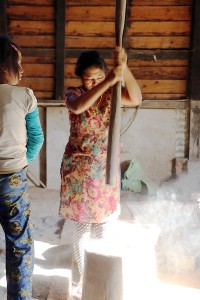 Weathered rock and Serpentine rock are two main raw materials used in this pottery, unique to Longpi villages. The two rocks are powdered and mixed with water to form clay-like consistency. The mixture is kneaded for one day, and is flattened on a wooden board before the pottery is molded. Only Hands and tools are used to mould each and every item. Dried and hard clay is baked in a kiln at high temperatures before finishing the items by rubbing the surface with bees wax giving it a nice shine. Cane strips are then woven through incisions made by skilled basketry artists.
Weathered rock and Serpentine rock are two main raw materials used in this pottery, unique to Longpi villages. The two rocks are powdered and mixed with water to form clay-like consistency. The mixture is kneaded for one day, and is flattened on a wooden board before the pottery is molded. Only Hands and tools are used to mould each and every item. Dried and hard clay is baked in a kiln at high temperatures before finishing the items by rubbing the surface with bees wax giving it a nice shine. Cane strips are then woven through incisions made by skilled basketry artists.
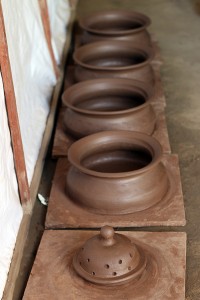 They have special features that retain the heat and freshness of cooked food for a long period. The raw materials used in the pottery are completely natural and no chemicals are used. Ideal companions in storing food and decorating your house,
A very significant part of making black pottery is to assemble and prepare the rocks that make up the raw material for the product. These serpentine rocks are collected from the mountainous regions and carried downhill on foot for about 5-6 kms. They are then pounded and broken in a wooden & bamboo pounding vessel known as “Sumban”.
They have special features that retain the heat and freshness of cooked food for a long period. The raw materials used in the pottery are completely natural and no chemicals are used. Ideal companions in storing food and decorating your house,
A very significant part of making black pottery is to assemble and prepare the rocks that make up the raw material for the product. These serpentine rocks are collected from the mountainous regions and carried downhill on foot for about 5-6 kms. They are then pounded and broken in a wooden & bamboo pounding vessel known as “Sumban”.
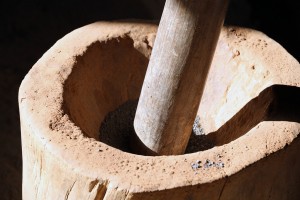 When an order for a pottery is placed, the village folk stay back and work on the potteries with complete dedication because it means food for a day for one household.
Remember whenever you are placing an order, you are not just buying a decorative piece or a kitchen item, you are not just preserving an age old tradition of these people, but you are most importantly helping the prime bread earners of a family put a morsel of food in the mouth of their old and young ones and themselves. The money you spend makes a huge impact on those people who wake up every day with the hope that their honest products make more sales in this urban world of ours.
When an order for a pottery is placed, the village folk stay back and work on the potteries with complete dedication because it means food for a day for one household.
Remember whenever you are placing an order, you are not just buying a decorative piece or a kitchen item, you are not just preserving an age old tradition of these people, but you are most importantly helping the prime bread earners of a family put a morsel of food in the mouth of their old and young ones and themselves. The money you spend makes a huge impact on those people who wake up every day with the hope that their honest products make more sales in this urban world of ours.
Water Hyacinth: Converting a menace into a fashionable blessing
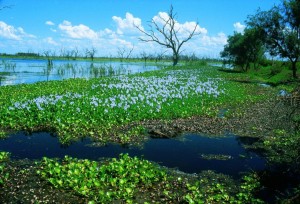 What happens when your unique style is also eco-friendly? It shows that you are here to make a difference and hence the story of this combination of eco-style will fascinate you.
Water hyacinth is a weed abundant in the entire stretch of Northeast India. It is a weed that grows in the water bodies forming a thick layer, preventing the oxygen inflow into them. It affects water ecosystems and the whole ecological balance by disrupting lives of marine animals.
However, if used smartly, they can be converted into beautiful products. Water hyacinth based eco-friendly handcrafted products are produced as a government initiative to promote sustainable livelihood in the rural areas of Northeast India. At the right hands, they become great bags, coin purses, office accessories, conference folders, jewelry, furniture and other home decor items.
What happens when your unique style is also eco-friendly? It shows that you are here to make a difference and hence the story of this combination of eco-style will fascinate you.
Water hyacinth is a weed abundant in the entire stretch of Northeast India. It is a weed that grows in the water bodies forming a thick layer, preventing the oxygen inflow into them. It affects water ecosystems and the whole ecological balance by disrupting lives of marine animals.
However, if used smartly, they can be converted into beautiful products. Water hyacinth based eco-friendly handcrafted products are produced as a government initiative to promote sustainable livelihood in the rural areas of Northeast India. At the right hands, they become great bags, coin purses, office accessories, conference folders, jewelry, furniture and other home decor items.
